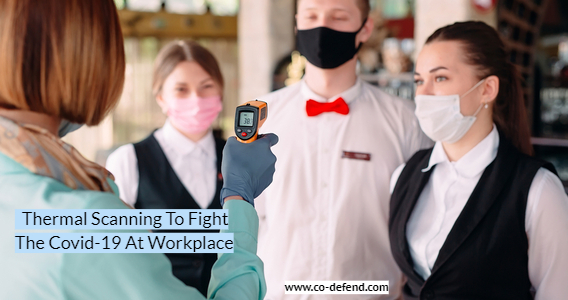The Global shutdown caused by the pandemic; Covid-19, has forced many businesses to take important actions in the beginning. We’ve witnessed a worldwide acceptance of the ‘Work From Home’ culture initially. Now that organizations are gearing up for re-opening their workspaces for operation, they have to take some drastic measures to ensure their employee’s safety. Necessary protocols issued by the government need to be followed in order to open the workspace for operation after the pandemic. Personal Protective Equipment and safety masks have become an essential item on the employees’ part. As for employers, the government has issued guidelines including installation of thermal scanners and sanitizing the whole infrastructure. The main purpose of releasing such extreme solutions is to ensure that further cases of COVID-19 are under check until a proper vaccine arrives.
Turning to technology-based solutions was imminent and sooner or later we were going to witness this takeover of technology in our life. We’ve already experienced worldwide usage from simple technology such as thermometer guns to more advanced tech like heat-detection cameras. Such technology can help a lot in keeping track of individuals who might have the disease or have flouted the social distancing rule in some ways.
Before we dig deep into the practical applications and the benefits of Thermal Scanning cameras, let us first take a look at what this technology actually is:
What is Thermal Image Scanning?
Thermal Scanning frameworks use infrared cameras to recognize skin temperature without genuinely getting in contact with the skin. For the last 20 years, this technology was used only by limited industries. However, Right now, they are being utilized in legislative and military applications, in transportation, food handling, assembling plants, and every other sector widely.
Benefits Of Thermal Scanning
The whole point of introducing new technology is to ensure that people are following the rule of social distancing. Furthermore, it also makes sure that the person operating such a system will not get in contact with anyone as he/she can monitor from a distance. It eliminates the need of wearing Personal protective equipment(PPE Kit) all the time.
Thermal imaging frameworks for the most part have been accurate to precisely measure somebody’s surface skin temperature quicker than the typical thermometer that requires a nearby distance or actual contact with the individual being assessed. This implies that thermal imaging systems are very much adjusted to assess a large number of individuals in measuring their temperature in high throughput areas such as ports, air terminals, train stations, gaming zones, and different spots where huge quantities of people should be filtered in a brief timeframe. For managers and employers that work with food preparing plants, building destinations, enormous assembling plants, or comparative high-traffic organizations, this part of the framework could be well welcomed. It could settle the calculated difficulties of employers to wait at the entry point for their temperature to be taken by an individual.
Thermal Scanning systems can likewise be a proficient and successful technique that might be forced by government or private organizations, for example, it can be imposed by the construction owners. For instance, in Colorado, New Jersey, and New York City, among others, businesses in specific ventures are advised to regularly check the temperature of their employees at the workplace.
The only major disadvantage of thermal scanning is that it won’t be identified if the person actually has the COVID-19 or not. This is because most of the latest cases are asymptomatic. But it can be effective in stopping the further spread.
Practical Tips for using Thermal Scanning
We’ve already witnessed the examples of Thermal Scanning after the lockdown restrictions ended. Now let’s look at Some Practical tips for using Thermal Scanning widely are:
- Brief your employees about the functioning of such systems with proper signs, policies, etc.
- If the person monitoring the system is closer to employees, suggest him to wear a PPE Kit for safety.
- Allow your employees to put in their opinions before installing such a system as the consent of the persons getting tested is necessary.
- The area must be sanitized and must meet each and every requirement of the system before installation.
- Keep the testing results confidential as it is against the law to reveal such stats.
Wrapping Up
Thermal Imaging systems might not be perfect but are a better solution than hand-held temperature guns; guns that make the tester also vulnerable to catching the virus. If used correctly and under the right circumstances, these systems can prove to be highly efficient and effective.
We at Co-Defend are keeping our eyes out on the technological advancements in this regard and will continue to monitor the situation with Covid-19 at each turn. Make sure you are subscribed to our newsletter to receive the latest updates on the Covid-19 situation. Furthermore, avail high-level PPE kits and other related products from the best Bulk PPE Suppliers in the USA. Reach out to us in the connect section for any queries.
FAQs
Q1. What is meant by Thermal Scanning?
Ans. Thermal Scanning uses Infrared technology that does not emit any kind of radiation and is used to detect and record the surface temperature of the skin to determine if the individual has a fever or not.
Q2. How Accurate in Thermal Scanning?
Ans. if placed and operated correctly, thermal scanning can prove to be pretty useful in determining the skin temperature of any individual accurately without actually being in contact with that person.
Q3. How far a Thermal Camera can see?
Ans. The actual length of a thermal camera is the same as the eyes, however, detecting and reading the temperature can be determined at a certain position. Such a Camera is accurate up to .1 degree Celsius.
